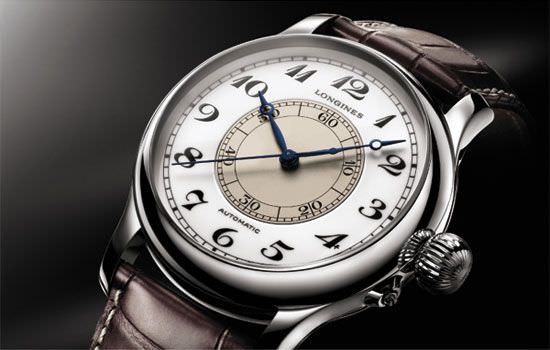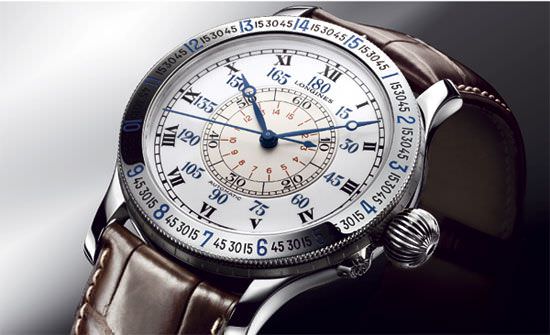There are museums and museums. Some contain historical masterpieces but are stuffy and unimaginative, some are incomprehensible compilations of unrelated memorabilia that people or companies feel they cannot discard. Longines, however, has enlarged its museum to offer an inspired presentation of the company history and its manufacture of 34 million watches via handwritten ledgers of manufactured and purchased watches, posters and other printed ephemera, a presentation of watches manufactured during the fifty year period of 1957 and 2007, and finally a calm, shrine-like room displaying Longines’ most critically acclaimed and historical timepieces.

Walter von Känel
To commemorate its 175 years, Longines also commissioned the historian Laurence Marti to produce a magnificent tome entitled A Region in Time: A socio-economic history of the Swiss valley of Saint-Imier and the surrounding area, 1700-2007. The work not only covers the extraordinary history of the region and its diverse industries, but also underlines the importance of the role Longines played in its development.
Walter von Känel, Longines’President, in his own inimitable and good-humoured manner, welcomed the local dignitaries to the special event and after underlining the various milestones of the company in its lengthy history of producing an incredible 34 million timepieces since its founding, proudly stated that, “… in the St Imier’s turbulent horological years from the 1700s through to 2007, there is a Great Lady, Longines, that is still here!”
Weems Second-Setting Watch
But Longines is about watches and to accompany the event the brand chose to tip its hat to the aviation pioneers by way of the Weems Second-Setting Watch and The Lindberg Hour Angle Watch.
Before Lindberg and his Hour Angle Watch, Captain Philip van Horn Weems – often referred to as the Grand Old Man of Navigation - developed the ‘Weems System of Navigation’ and invented the Second Setting Watch - a watch enabling navigators to find Greenwich Mean Time from the watch’s dial. When setting a watch, hours and minute hands can be adjusted, but the second hand continues on its continuous path. To most people, the loss or gaining of twenty seconds is of no consequence, but for a navigator prior to the GPS systems it was often of life threatening consequences. Having noted the time difference in seconds when they synchronized their watch with the GMT or any other observatory time, navigators had to continually make calculations, but Weems mounted a movable rim on his watch, marked the sixty seconds and, since he was unable to adjust the second hand to the watch dial, he simply adjusted the dial to the hand. The year was 1927, which, as it happens, is the year Europa Star was founded.
Exactly 80 years later, Longines has been inspired to revive this simple system and place it into an elegant and functional Weems Second-Setting Watch (47.50 mm) as a tribute to the American navigator.

THE WEEMS SECOND-SETTING WATCH
Stainless steel (47.50 mm) second-setting watch equipped with a Calibre L699 (ETA A07 111) mechanical automatic movement. White lacquered dial, rotating dial centre in silvered opaline for the synchronization of the seconds, blued ‘Breguet’-style hands, exterior black painted railway track indicating the minutes, painted Arab numerals, sapphire crystal, engraved caseback with opening, ‘Louis XV’ style crown, brown alligator strap, water-resistant to 30 metres.
The Lindberg Hour Angle Watch
Charles A. Lindberg, a pupil of Weems, took up the Weems concept after his transatlantic solo flight from New York to Paris in 33 hours and 30 minutes. He used it as an additional feature in his own Hour Angle Watch, patented in 1935, and since then Longines has adapted a time correction feature using rotating dials on some of its watches equipped with a central seconds hand.

THE LINDBERG HOUR ANGLE WATCH
Stainless steel watch (47,50 mm) equipped with a self-winding mechanical movement L699 (ETA A07 111) with a 42-hour power reserve. Hours, minutes and seconds functions, indication of longitude in degrees and minutes of arc, rotating centre dial for synchronization of the seconds hand with a radio time signal, rotating bezel for variations in the equation of time. ‘Louis XV’ style crown, silvered rotating centre dial, blued Breguet-style hands, leather strap, water-resistant to 30 metres.
At 47.45 mm, this ‘oversized’ model reverts back to the original dimensions of the watch, based on the patent registered in conjunction with Longines by Captain Weems. Basically the watch could be synchronized to the nearest second with a radio time signal using the outer bezel of the central dial. The watch was ‘oversized’ because in the darkness of the cockpit of a ‘plane it is easier to read and manipulate – especially with its large, knurled crown.
This imposing, yet resplendent timepiece is in stainless steel with a pair of Breguet-style hands and the seconds on a white lacquered dial. The seconds hand is synchronized to a radio time signal via the silvered rotating centre dial with its black painted double minute track and red numerals. The blue and black Arabic numerals engraved on the case’s rotating bezel serve to adjust it to daily variations in the equation of time. The watch is completed by a hinged back cover which can be lifted to reveal a sapphire caseback.
Two brilliant additions to the magnificent Longines collections, but then we have come to expect that from them, just as we expect aviators to be lusting after their watches.
Source: Europa Star April-May 2007 Magazine Issue





